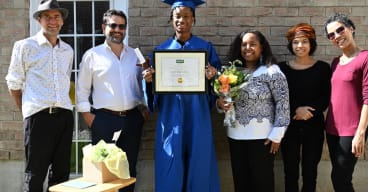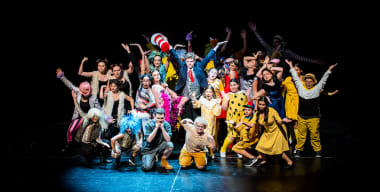Four teachers from Crescent School in Toronto with varying backgrounds and levels of expertise in the subject came together to change that perception and work on a way to make math enjoyable for all students. The group worked together to allow students to appreciate the complexities of problem solving, understand the benefits of working collaboratively and become learners who are comfortable with their numerical abilities.
This group of educators' approach was to work as a team to collaboratively plan the units and the individual lessons throughout the year that were developed using the curriculum focal points highlighted by the National Council of Teachers of Mathematics (NCTM) in 2006 and the EduGAINS online learning network. The team met once every eight days for 75 minutes to ensure that a consistent approach was being taken, lessons were meeting outcomes and strategies were being implemented to create lifelong learners of mathematics, the original goal of the group.
Research on teaming compiled by Karin Goetz from the University of Calgary has highlighted key elements that the team possessed which helped it to succeed. Throughout the literature on team teaching, including the reflections by teachers who have teamed during their careers, certain key elements appear to be necessary for a successful team-teaching program: compatibility of team members, shared commitment to team teaching and ongoing communication, a keen interest in connecting the content or curriculum to real life, and a strong desire to ignite students' thirst for knowledge.
Teaching Students to Think for Themselves
Back at Crescent School, our own internal professional learning community came up with the primary goals to create lifelong learners and to teach students how to learn in a manner that fits their learning style. More specifically from a mathematics perspective, we want the students to value mathematics, be confident in their ability to do mathematics, become mathematical problem solvers, and learn to communicate and reason mathematically. In order for them to reach these goals, the students must take control of their own learning, create their own understanding of the material presented to them and understand how they best learn to do so. We want to teach students how to think for themselves, not what to think.
Research published in Educational Leadership by Harvey Silver, Richard Strong and Matthew Perini on learning, intelligence and the brain suggests that we learn best when we are engaged in meaningful classroom learning experiences that help us discover and develop our strengths and talents. If we can create as many of these experiences as possible, we can hopefully motivate students to take control of their learning and develop the persistence and effort that is necessary to reach these goals.
Carrots and sticks work, but only in a surprisingly narrow band of circumstances. For enduring motivation and high performance, autonomy, mastery and purpose are much better." —Daniel Pink on Motivation 3.0 from Drive: The Surprising Truth About What Motivates Us
Encouraging Understanding vs. Memorization
In order to foster understanding, we looked at top education researcher and author Robert Marzano's elements of effective pedagogy, including instructional strategies, management techniques and curriculum design. Using instructional strategies based on current brain research, we can try to focus students' understanding and get them to use the content rather than memorize isolated bits of information. This "new" information that the student is engaged in learning focuses on authentic tasks or real-life situations. These are tasks that require problem solving, as well as creative and critical thinking. In order to do this, we focused the curriculum around key or big ideas rather than merely trying to cover content.
NCTM suggests it is important that we recognize and teach to the varied intelligences within the classroom as well as help the students use metacognitive strategies when they engage in problem solving. By doing so, we can increase our students' learning and problem-solving abilities by providing them with the tools necessary to use all facets of their learning style and intelligence, write Terrence Parry and Gayle Gregory in their book Designing Brain-Compatible Learning.
We have chosen to use the "backwards planning" curriculum design model for this reason. Backwards planning is the practice of looking at the outcomes first, and what understanding you want the students to obtain, in order to design the curriculum units, performance assessments and classroom instruction. The word "understanding" forms the basis of the backward design model; its meaning is complex and everyone's definition can be different. "Understanding involves sophisticated insights and abilities, reflected in varied performances and contexts," writes Jay McTighe in Understanding by Design. "While there are several types of understandings, knowledge and skills do not automatically lead to understanding."
Nearly 50 percent of the students in our Grade 7 classes are new to the school and are coming with various mathematical backgrounds and learning styles. One of the very first key elements in designing the curriculum for the boys was the administration of a learning styles inventory for each student so that as teachers we could gain insight into the class learning profile. An additional objective was for each student to begin to recognize and take responsibility for understanding his learning profile.
Co-operative Learning Strategies
It was important to allow the group to begin to incorporate co-operative learning strategies in the lessons. Co-operative learning is very different from group work. The term "co-operative learning" refers to an instructional method in which students at various performance levels work together in small groups toward a common goal. The students are responsible for one another's learning as well as their own. Thus, the success of one student helps other students to be successful. The shared learning gives students an opportunity to engage in discussion, take responsibility for their own learning, and thus become critical thinkers, according to Samuel Totten in Cooperative Learning: A Guide to Research.
The mathematics curriculum in grades 7 and 8 contains a significant overlap of standards. Creating understanding in the students' learning versus mere memorization would require spending a greater deal of time developing concepts in instructional methods. In order to accomplish this, the group mapped out the standards from the Grade 7 and 8 curricula and streamlined the concepts being taught. Unpacking curriculum standards provides subject matter experts with an opportunity to delete content that is not considered essential, delete content that is not amenable to classroom assessment and combine content that is highly related, according to Marzano.
Now that the standards were set and the students and teachers knew how each individual learned in co-operative settings and dealt with new material, it was time to start building the individual lessons. The group decided to use the three-part lesson format. This format begins by listing the big ideas that are being covered for the unit or lesson. After this, it breaks the lesson down into three core parts: minds on, activity (lesson) and consolidated debrief.
"Minds on" aims to get students mentally engaged in a positive classroom environment. The "activity" involves the lessons and tasks carried out using effective strategies to meet the expectations of the lesson and ensure each student understands what he or she is learning. We tried to pick activities that focused on thinking rather than on one correct solution. The "consolidated debrief" element allows the teacher to assess if the students can explain and justify their answers and the checkpoints for understanding are met. This format allowed us to take advantage of differentiated instruction techniques in the lesson design and follow-up assessment.
In Middle Ground magazine in 2002, teacher and columnist Rick Wormeli highlighted what experienced teachers have always known and brain research confirms:
- No two children are alike or learn in identical ways.
- A successful learning environment for one child is not necessarily successful for another.
- Children need to learn to think for themselves.
Five Strands of Mathematical Literacy
The core assessment for the lessons incorporated problem solving and addressed the five strands of mathematical literacy derived from the book Adding It Up: Helping Children Learn Mathematics and the National Research Council:
- Conceptual Understanding: Comprehending mathematical concepts, operations and relations—knowing what mathematical symbols, diagrams and procedures mean.
- Procedural Fluency/Computing: Carrying out mathematical procedures, such as adding, subtracting, multiplying and dividing numbers, flexibly, accurately, efficiently and appropriately.
- Strategic Competence/Applying: Being able to formulate problems mathematically and to devise strategies for solving them using concepts and procedures appropriately.
- Adaptive Reasoning: Using logic to explain and justify a solution to a problem or to extend from something known to something not yet known.
- Productive Disposition/Engaging: Seeing mathematics as sensible, useful and doable—if you work at it—and being willing to do the work.
In order to try to reach each of these strands, assessments need to be varied, authentic and differentiated to meet the students' needs. We have used RAFT (Role/Audience/Format/Topic) assessments where students have various choices in how they want to show their level of understanding on a certain topic (see the RAFT sidebar). In another type of assessment, we created a culminating task called "Robot Reprogramming," where a group of students are given a pre-programmed robot and they need to problem solve to map the path of the robot and communicate that in different forms: fractions, integers and ratios. The goal was to use the robot as a tool to assess their understanding of the concepts of number sense and numeration in a real-world situation. This led into an interesting discussion about the use of mathematics in modelling, programming and computer code, for instance. The goal for the students is for them to see the relevance of mathematics in their everyday lives and be able to honestly and openly assess one another and themselves. This open communication and fearless reflection and questioning will hopefully create more inquisitive and higher- order-thinking students, as well as create some resiliency within them when they have to assess and defend their own work. The reflection is key in that they need to see solutions that they might not have thought of and be able to see the value in other people's ideas. In a positive classroom environment, it can only create confidence within the students when they are praised by their peers rather than adults.
Accepting that students cannot learn mathematics is as intolerable as accepting that students cannot read or write. Even less tolerable than the two tenets above is having students who cannot think for themselves and therefore take no interest in their learning. The diverse team of educators began a journey in late September that did not have a prescribed route with clear signposts along the way. What they did have was the combined knowledge of four experienced educators who instinctively knew that fostering a love for mathematics and allowing students to come to their own understandings was the only way to begin to make a difference in the way the subject was seen by individuals. Mathematics could no longer be thought of as an optional pursuit that was understood only by people who were somehow blessed with a predisposition to it the way a 6-foot-10 individual may be drawn toward basketball. These lessons were for the Spud Webbs of the math world.
RAFT Assignment Excerpt
Dear Abby, My name is Radius, and I don't get treated with any respect. I am in a relationship with area of a circle who thinks that it's got it all covered. It keeps telling me that I'm only half of the diameter. I can't help that. That's my definition! I am used for other formulas that have nothing to do with the area of the circle. I am also part of the formula for the area of a cylinder, volume of a cylinder, and circumference of a circle. Since I have other relationships, I think the area of the circle should be careful. Yours truly, Radius
—Jeff Adams & Michael Ruscitti









